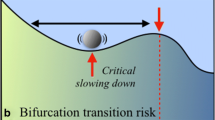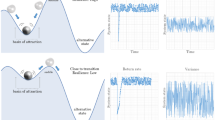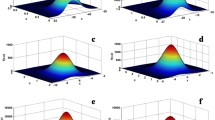Abstract
Most work on generic early warning signals for critical transitions focuses on indicators of the phenomenon of critical slowing down that precedes a range of catastrophic bifurcation points. However, in highly stochastic environments, systems will tend to shift to alternative basins of attraction already far from such bifurcation points. In fact, strong perturbations (noise) may cause the system to “flicker” between the basins of attraction of the system’s alternative states. As a result, under such noisy conditions, critical slowing down is not relevant, and one would expect its related generic leading indicators to fail, signaling an impending transition. Here, we systematically explore how flickering may be detected and interpreted as a signal of an emerging alternative attractor. We show that—although the two mechanisms differ—flickering may often be reflected in rising variance, lag-1 autocorrelation and skewness in ways that resemble the effects of critical slowing down. In particular, we demonstrate how the probability distribution of a flickering system can be used to map potential alternative attractors and their resilience. Thus, while flickering systems differ in many ways from the classical image of critical transitions, changes in their dynamics may carry valuable information about upcoming major changes.




Similar content being viewed by others
References
Bjornstad ON, Grenfell BT, Bjørnstad ON (2001) Noisy clockwork: time series analysis of population fluctuations in animals. Science 293:638–643
Brock WA, Carpenter SR (2012) Early warnings of regime shift when the ecosystem structure is unknown. PLoS One 7:e45586
Carpenter SR, Brock WA (2006) Rising variance: a leading indicator of ecological transition. Ecol Let 9:311–318
Carpenter SR, Brock WA (2010) Early warnings of regime shifts in spatial dynamics using the discrete Fourier transform. Ecosphere 1:art10
Carpenter SR, Brock WA (2011) Early warnings of unknown nonlinear shifts: a nonparametric approach. Ecology 92:2196–2201
Carpenter SR, Ludwig D, Brock WA, Columbia B (1999) Management of eutrophication for lakes subject to potentially irreversible change. Ecol Appl 9:751–771
Carpenter SR, Brock WA, Cole JJ, Kitchell JF, Pace ML (2008) Leading indicators of trophic cascades. Ecol Let 11:128–138
Carpenter SR, Cole JJ, Pace ML, Batt R, Brock WA, Cline T et al (2011) Early warnings of regime shifts: a whole-ecosystem experiment. Science 332:1079–1082
Cimatoribus AA, Drijfhout SS, Livina V, Van der Schrier G (2012) Dansgaard–Oeschger events: tipping points in the climate system. Clim Past Disc 8:4269–4294
Contamin R, Ellison AM (2009) Indicators of regime shifts in ecological systems: what do we need to know and when do we need to know it? Ecol Appl 19:799–816
Dakos V, Scheffer M, Van Nes EH, Brovkin V, Petoukhov V, Held H (2008) Slowing down as an early warning signal for abrupt climate change. PNAS 105:14308–14312
Dakos V, Van Nes EH, Donangelo R, Fort H, Scheffer M (2010) Spatial correlation as leading indicator of catastrophic shifts. Theor Ecol 3:163–174
Dakos V, Kéfi S, Rietkerk M, Van Nes EH, Scheffer M (2011) Slowing down in spatially patterned ecosystems at the brink of collapse. Am Nat 177:E153–E166
Dakos V, Carpenter SR, Brock WA, Ellison AM, Guttal V, Ives AR et al (2012a) Methods for detecting early warnings of critical transitions in time series illustrated using simulated ecological data. PLoS One 7:e41010
Dakos V, Van Nes EH, D’Odorico P, Scheffer M (2012b) Robustness of variance and autocorrelation as indicators of critical slowing down. Ecology 93:264–271
Dansgaard W, Johnsen SJ, Clausen HB, Dahl-Jensen D, Gundestrup NS, Hammer CU et al (1993) Evidence for general instability of past climate from a 250-kyr ice-core record. Nature 364:218–220
Ditlevsen PD, Johnsen SJ (2010) Tipping points: early warning and wishful thinking. Geoph Res Let 37:2–5
Drake JM, Griffen BD (2010) Early warning signals of extinction in deteriorating environments. Nature 467:456–459
Ganopolski A, Rahmstorf S (2002) Abrupt glacial climate changes due to stochastic resonance. Phys Rev Let 88:038501
Guttal V, Jayaprakash C (2007) Impact of noise on bistable ecological systems. Ecol Model 201:420–428
Guttal V, Jayaprakash C (2008) Changing skewness : an early warning signal for regime shifts in ecosystems. Ecol Let 11:450–460
Guttal V, Jayaprakash C (2009) Spatial variance and spatial skewness: leading indicators of regime shifts in spatial ecological systems. Theor Ecol 2:3–12
Hastings A, Wysham DB (2010) Regime shifts in ecological systems can occur with no warning. Ecol Let 13:464–472
Held H, Kleinen T (2004) Detection of climate system bifurcations by degenerate fingerprinting. Geoph Res Let 31:1–4
Hirota M, Holmgren M, Van Nes EH, Scheffer M (2011) Global resilience of tropical forest and savanna to critical transitions. Science 334:232–235
Horsthemke W, Lefever R (2006) Noise-induced transitions: theory and applications in physics, chemistry, and biology. Springer, Berlin
Ives AR, Dakos V (2012) Detecting dynamical changes in nonlinear time series using locally linear state-space models. Ecosphere 3
Kramer MA, Truccolo W, Eden UT, Lepage KQ, Hochberg LR, Eskandar EN (2012) Human seizures self-terminate across spatial scales via a critical transition. PNAS 109:21116–21121
Lenton TM, Livina VN, Dakos V, Van Nes EH, Scheffer M (2012) Early warning of climate tipping points from critical slowing down: comparing methods to improve robustness. Phil Trans R Soc A 370:1185–1204
Livina VN, Kwasniok F, Lenton TM (2010) Potential analysis reveals changing number of climate states during the last 60 kyr. Clim Past 6:77–82
Perretti CT, Munch SB (2012) Regime shift indicators fail under noise levels commonly observed in ecological systems. Ecol Appl 22:1772–1779
Ridolfi L, D’Odorico P, Laio F (2011) Noise-induced phenomena in the environmental sciences. Cambridge University Press, Cambridge, p 322
Scheffer M, Bascompte J, Brock WA, Brovkin V, Carpenter SR, Dakos V et al (2009) Early-warning signals for critical transitions. Nature 461:53–59
Scheffer M, Carpenter SR, Lenton TM, Bascompte J, Brock W, Dakos V et al (2012a) Anticipating critical transitions. Science 338:344–348
Scheffer M, Hirota M, Holmgren M, Van Nes EH, Chapin FS (2012b) Thresholds for boreal biome transitions. PNAS 109:21384–21389
Strogatz SH (1994) Nonlinear dynamics and chaos with applications to physics, biology, chemistry and engineering. Perseus Books, Reading, p 498
Svensson A, Andersen KK, Bigler M, Clausen HB, Dahl-Jensen D, Davies SM et al (2008) A 60 000 year Greenland stratigraphic ice core chronology. Clim Past 4:47–57
Thompson JMT, Sieber J (2010) Climate tipping as a noisy bifurcation: a predictive technique. IMA J Appl Math 76:27–46
Van Nes EH, Scheffer M (2005) Implications of spatial heterogeneity for regime shifts in ecosystems. Ecology 86:1797–1807
Veraart AJ, Faassen EJ, Dakos V, Van Nes EH, Lürling M, Scheffer M (2012) Recovery rates reflect distance to a tipping point in a living system. Nature 481:357–359
Wang R, Dearing JA, Langdon PG, Zhang E, Yang X, Dakos V, Scheffer M (2012) Flickering gives early warning signals of a critical transition to a eutrophic lake state. Nature 492:419–422
Wiesenfeld K (1993) An Introduction to Stochastic Resonance. In: Buchler JR, Kandrup HE (eds) Stochastic processes in astrophysics. The New York Academy of Sciences, New York, pp 13–25
Wissel C (1984) A universal law of the characteristic return time near thresholds. Oecologia 65:101–107
Acknowledgements
We thank Serguei Saavedra and the two anonymous reviewers for helpful comments. We are grateful to Steve Carpenter and Tim Cline for providing us with the planktivorous data for Fig. 1c from the Cascade Project at the University of Wisconsin-Madison, funded by US NSF. We also thank John Drake for allowing us to use the zooplankton data in Fig. 1d. VD is supported by a Rubicon fellowship from the Netherlands Science Foundation (NWO). EvN and MS acknowledge funding from an Advanced ERC grant awarded to MS.
Author information
Authors and Affiliations
Corresponding author
Electronic supplementary material
Below is the link to the electronic supplementary material.
ESM 1
(PDF 47925 kb)
(MPG 5328 kb)
(MPG 553 kb)
(MPG 2074 kb)
(MPG 300 kb)
Rights and permissions
About this article
Cite this article
Dakos, V., van Nes, E.H. & Scheffer, M. Flickering as an early warning signal. Theor Ecol 6, 309–317 (2013). https://doi.org/10.1007/s12080-013-0186-4
Received:
Accepted:
Published:
Issue Date:
DOI: https://doi.org/10.1007/s12080-013-0186-4




